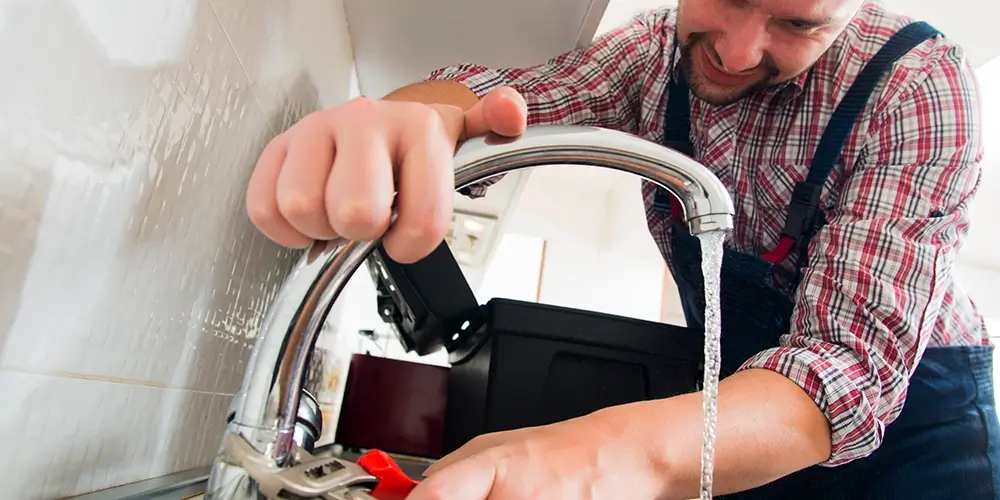It’s easy to ignore the faucets in your home — until something goes wrong.
They hold the power to ruin a good night’s sleep.
- That big job interview? It’s toast. You didn’t get a wink of sleep because the bathroom faucet was dripping all night.
- That holiday dinner you were planning for the relatives? Try conjuring up a 5-course meal when nary a drop flows from the kitchen tap.
Faucets endure heavy use and abuse. On, off, on again several times daily. Multiply that number by a factor of four (or whatever) if you share your home with roommates or family.
Faucets are exposed to corrosive minerals and chemicals in water, extreme temperature changes, and unkind human treatment. It should be no surprise they sometimes spring leaks or stop working altogether.
Fortunately, most common faucet problems are easy to fix if you know what to look for.
1. Faucet Rust & Corrosion
By the time you notice rust on your faucet’s exterior, it has also formed on the inside.
Rusty water isn’t a health hazard for most people, but it can stain your sink, clothing, and other things it comes in contact with. Plus, how appealing is that glass of orange drinking water?
Faucet rust comes with age, but a water supply high in iron will accelerate the aging process.
Limescale is another corrosive byproduct of hard water.
A replacement is the best remedy for a rusty, corroded, or encrusted faucet. If you’re determined to salvage your old faucet somehow (sentimental reasons?), try rust-removal or descaling products — but don’t let them sit on the metal too long, and scrub off all residue when done.
Quality matters. Cheap faucets are a one-way ticket to messy plumbing futures. You don’t have to buy the latest and greatest overpriced designer brands, but faucet build quality should be first and foremost when replacing a worn-out fixture.
2. Low Water Pressure from the Faucet
The aerators of kitchen faucets are notorious for clogging with sediment. The same goes for bathroom faucets, but to a lesser extent because the water pressure is usually lower.
The aerator can be easily removed and cleaned or replaced in seconds.
If you have an older home, a rusty pipe may reduce water flow. Corroded galvanized pipes slow the flow and give water an unpleasant metallic taste.
Rusty pipes will have to be repiped or replaced.
3. Leaks from the Handle or Around the Spout Base
A worn-out O-ring can cause a dripping handle or spout. The good news is that replacing the O-ring is easy, requiring no tools or special skills except knowing which size and type to buy.
If you have old faucets with rubber washers, they may be worn and need replacement.
Sometimes the leak stems from a loose screw or connection. Tighten the screws first and move on to other remedies only if the problem persists.
4. A Sticky, Hard-to-Turn Faucet Handle
Mineral buildup in valves and stems can restrict the movement of the handle, making it difficult (or even impossible) to turn. You’ll need to remove and disassemble the faucet parts and clean them with a mineral-removal product.
An alternative solution is to replace the valve stem or cartridge with a new one.
5. No Water Coming from the Faucet
Old valves again. *Sigh*
Standard faucet designs include a circular valve to trap dirt. Newer models have several chambers and are more efficient but prone to sediment buildup.
You’ll need to disassemble the faucet to access and clean the valve. If that doesn’t work, it may be time to replace the entire faucet assembly or cartridge.
6. Dripping Faucet (aka Water Torture!)
A leaking faucet is the most common and annoying household faucet problem. It wastes water, raises your water bill and blood pressure, and poses a threat to furniture and flooring if an unattended sink overflows.
A dripping faucet usually means a worn-out O-ring or washer inside the valve, so check and replace it if necessary. For compression faucets, ensure the screws are tight.
If you have an old faucet with rubber washers, replace them all since their lifespan is limited.
7. Excessive Faucet Noise
A faucet may whistle, scream, or chatter. You might expect this behavior from your parrot but not your faucet.
Unusual noises could be a symptom of a serious plumbing problem. Call in the pros; it’s no time to fool around.
Sometimes, a loose washer can whistle like a tea kettle, but the issue more often lies with the pipes.
8. Faulty Faucet Sprayer
If the sprayer isn’t working, it could be due to a hole in the hose or a clogged nozzle. Inspect them both. Clean or replace as needed. Vinegar works well to remove mineral deposits.
It may also involve air pressure; turn up the hot water to boost its flow rate.
Finally, ensure the valve nut is tight, as a loose connection can cause issues with water flow. If all that fails, buy a new sprayer unit and fit it yourself — most are easy enough to install without professional help.
9. Faucet Installation Problems
Thanks to DIY shows and videos, improper faucet installation is a growing problem in Plumber Land.
We don’t mean to spoil your fun or quash your inner handyman, but please read and understand the installation instructions and have all the tools on hand before attempting the job.
A botched DIY installation can cause water leaks, pressure issues, and other disasters. It may even void your insurance coverage for the ensuing repair!
Call a professional plumber if the job seems too difficult to handle. It’s better (and cheaper!) in the long run.
FAQs: Fixing Faucet Problems
Q: What causes a squeaky faucet handle?
Aging or dry internal components can make a faucet handle squeak. Applying lubricant to the handle’s stem may eliminate the noise.
Q: Why is there low water pressure from my faucet?
Low water pressure can be due to a clogged aerator, blocked pipes, or faulty plumbing. Try cleaning the aerator or consulting a plumber.
Q: How do I fix the water hammer noise from the faucet?
A water hammer occurs when the water flow suddenly stops, causing a shock wave. Installing water hammer arrestors or checking for secure piping can mitigate this problem.
Q: Why is my faucet making a whistling sound?
Whistling usually indicates a worn valve or washer. Replacing these parts should fix the issue.
Q:. What do I do if my faucet handle is hard to turn?
This could be due to mineral buildup or a damaged cartridge. Cleaning the handle or replacing the cartridge usually resolves stiffness.
Q: Why is water leaking from the base of the faucet?
You may have a compromised O-ring or gasket. Replacing these components should stop the leak.
Q: Can I fix a faucet myself, or should I call a plumber?
Many faucet issues can be fixed with basic tools and a bit of knowledge. However, if you’re unsure or the problem persists after your attempts, do the smart thing and call a plumber.
Q: Why does my faucet have inconsistent water temperature?
Inconsistent water temperature could be due to a faulty mixing valve or problems with your water heater. Check the valve and the water heater to identify the issue.
Q: How often should I replace the parts in my faucet?
The lifespan of faucet parts varies, but it’s a good idea to inspect and potentially replace washers, O-rings, and cartridges every 3 to 5 years to prevent leaks and other issues.


